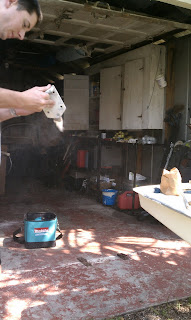A few weeks ago at Tillers International, we held a small foundry class. Students learned how to construct a small foundry, source metal, make green sand moulds and cast soft metals such as aluminum, brass and bronze.
The forge requires a few extra skills to build, but essentially it is a metal bucket with a hole in the bottom, lined with fireclay. You can then build a simple lid by packing wet fireclay into circle of sheet metal tack welded together and reinforced with some thin wire which acts as rebar.
You fill the forge with charcoal ( we make our own ) and introduce a forced air source to the hole in the bottom. A hair dryer works well. This system will attain temperatures well over 2000 degrees. A crucible is set in the forge on top of the charcoal and scrap metal is added to the crucible.
Here we are making two-part green sand moulds.. Its just two simple wooden frames that latch together on the sides. The green sand is wet enough that when packed, it does not need to be supported on the bottom. The method requires some planning, but is fairly simple. The trick is too think about where your center line will be. If you look at most cast objects, you will notice a line running down the center, where two halves of the mould join.You press the object you wish to mould into the packed sand halfway to the centerline. You then repeat the process using the opposite side in the second mould, adding a tapered tube of some sort (we use a piece of pool cue ) to the top mould which allows metal to be poured into the cavity created. Remove the objects, and you are left with two cavities which each form one half of the mould. Stack the boxes and secure the latches. The wet sand holds the shape of the object you pressed into it even when turned upside down.
Now the fun part. Pour the molten metal into the moulds through the holds left by the pool cues.
Let it cool, then bust it out. The sand can be sifted and reused.
That's my sweetheart "Ol' Faithful" on the right.





























































